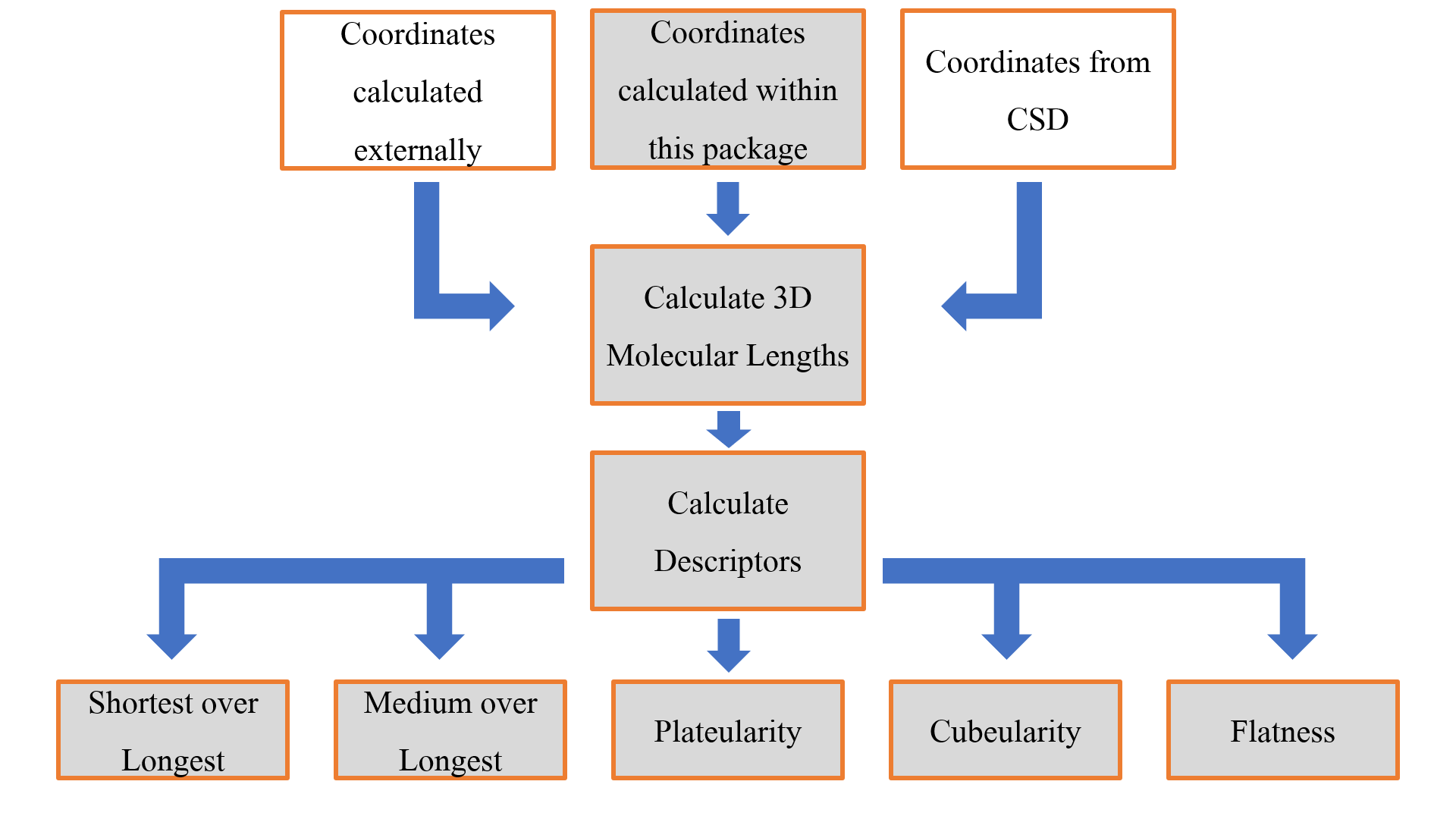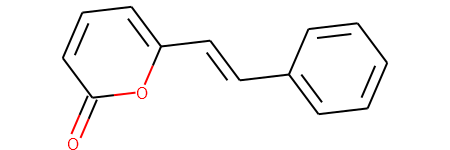The Molecular3DLengthDescriptors package can do the following:
- Calculates the lowest energy 3D conformer of a molecule using RDKit's UFF and MFF94 force fields.
- Converts an array of coordinates into a set of lengths: longest, medium and shortest.
- Descriptors can be calculated from these lengths.
You can use this tool to do the following:
- Calculate these descriptors for a machine learning project from 2D SMILES input.
- Calculate these descriptors using crystallogaphic molecular coordinates exported from a database such as the CSD.
- Calculate these descriptors using coordinates calculated via another method (eg: GROMACS, BALLOON, CONFAB... etc)
Installation of this package requires Python 3+.
You can install this package two ways...
via pip:
pip install Molecular3DLengthDescriptors
(https://pypi.org/project/Molecular3DLengthDescriptors/)
Or manually, by placing the Molecular3DLengthDescriptors folder within
~/.local/lib/pythonX.X/site-packages
The rdkit and numpy libraries are dependencies for this package. Install them with the following:
conda install numpy
https://www.rdkit.org/docs/Install.html
- Import package
import Molecular3DLengthDescriptors as md- Calculate 3D coordinates of 2D molecule
This code is based off Wicker et al's nConf20 descriptor (10.1021/acs.jcim.6b00565).
from rdkit.Chem import MolFromSmiles
smiles = "O=c1cccc(/C=C/c2ccccc2)o1"
mol_2D = MolFromSmiles(smiles)
mol_2Dcc = md.Lengths.ComputeCoordsFrom2D()
coordinates = cc.GetCoords(mol_2D)
coordinatesarray([[ 4.19392625, -2.10217421, 1.20758067],
[ 3.77614639, -1.12343758, 0.59832016],
[ 4.72136167, -0.18159364, -0.02926615],
[ 4.27935864, 0.88880918, -0.69605956],
[ 2.87057618, 1.13819338, -0.81141094],
[ 2.00047091, 0.2903415 , -0.24586024],
[ 0.56197146, 0.46799511, -0.31472371],
[-0.34101042, -0.35981258, 0.23919665],
[-1.81020273, -0.21901879, 0.19470342],
[-2.47547343, 0.83154283, -0.45235907],
[-3.87295236, 0.9032948 , -0.45516855],
[-4.62630912, -0.07414675, 0.18888447],
[-3.98359642, -1.12449045, 0.8365183 ],
[-2.58741845, -1.19525503, 0.83872962],
[ 2.44345336, -0.85157198, 0.4663684 ]])
- Calculate the lengths of the 3D molecule
The covariance of the molecular coordinates is calculated. Then eigenvectors and eigenvalues from the covariance matrix is calculated. The eigenvectors will be aligned in directions of most variance, least variance and right angles to both of those. Therefore, if the square root of the eigenvalues is taken these values will now be back on the same unit scale as the coordinates and hence can be interpreted as the lengths of the molecule.
lengths = md.Lengths.GetLengthsFromCoords(coordinates)
lengths[0.0001053619852081641, 1.124146300889793, 3.3578154223541476]
- Calculate descriptors
You can calculate individual descriptors:
print(md.Descriptors.Flatness(lengths))
print(md.Descriptors.Cubeularity(lengths))
print(md.Descriptors.Plateularity(lengths))
print(md.Descriptors.ShortOverLong(lengths))
print(md.Descriptors.MediumOverLong(lengths))0.0001053619852081641
1.0504929488912333e-05
35825.784590642164
3.1378134875053776e-05
0.334785019273531
Or all at once:
md.Descriptors.CalcAllDesc(lengths){'Flattness': 0.0001053619852081641,
'Cubeularity': 1.0504929488912333e-05,
'Plateularity': 35825.784590642164,
'ShortOverLong': 3.1378134875053776e-05,
'MediumOverLong': 0.334785019273531}
To explain what the descriptors mean, place help(...) around the function to output the docstring.
help(md.Descriptors.ShortOverLong)Help on function ShortOverLong in module Molecular3DLengthDescriptors.Descriptors:
ShortOverLong(lengths)
A measure of how cubic a molecules is.
0 means either a needle or plate shape.
1 means perfect cube
ShortOverLong = Shortest / Longest
help(md.Descriptors.CalcAllDesc)Help on function CalcAllDesc in module Molecular3DLengthDescriptors.Descriptors:
CalcAllDesc(lengths)
Flattness => Shortest length
Measure of how flat a molecules is.
Cubularity => (Shortest*Medium*Longest)/(Longest)**3
1 is a perfect cube.
Plateularity => (Medium*Longest)/ Shortest
Larger value, more 2D plate-like.
ShortOverLong => Shortest / Longest
1 is perfect cube, 0 is needle or plate-like
MediumOverLong => Medium / Longest
1 is perfect plate-like shape, 0 is perfect needle shape
If you use this package please feel free to reference us with:
Jewson, T., & Cooper, R. I. (2021). Molecular3DLengthDescriptors (1.0.0). https://github.com/ThomasJewson/Molecular3DLengthDescriptors
Or add this BibTeX entry to your .bib library:
@misc{Jewson2021,
author = {Jewson, Thomas and Cooper, Richard I.},
title = {{Molecular3DLengthDescriptors}},
url = {https://github.com/ThomasJewson/Molecular3DLengthDescriptors},
year = {2021}
}

